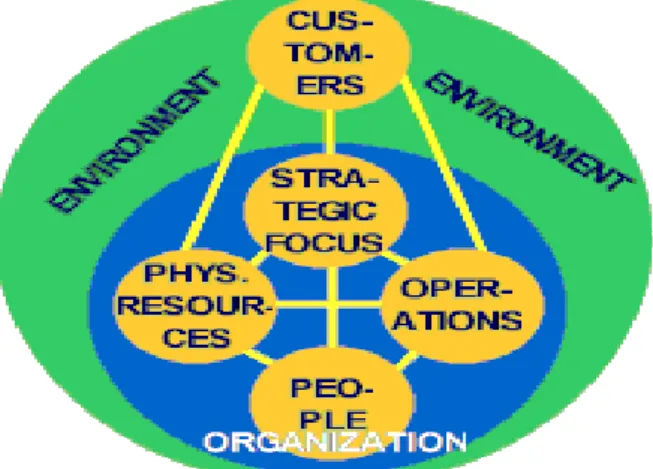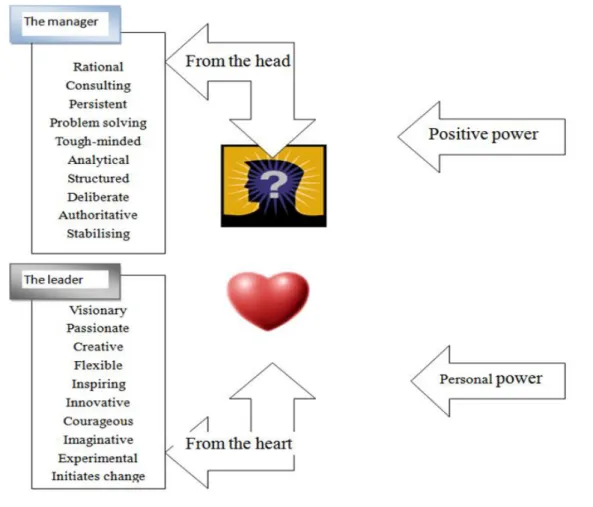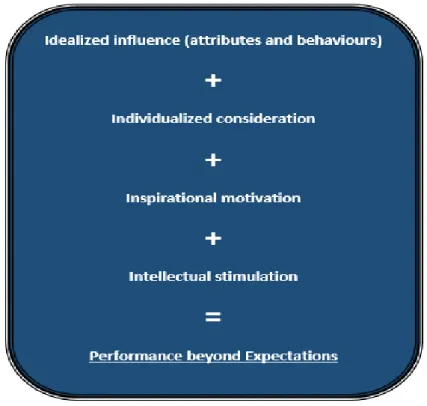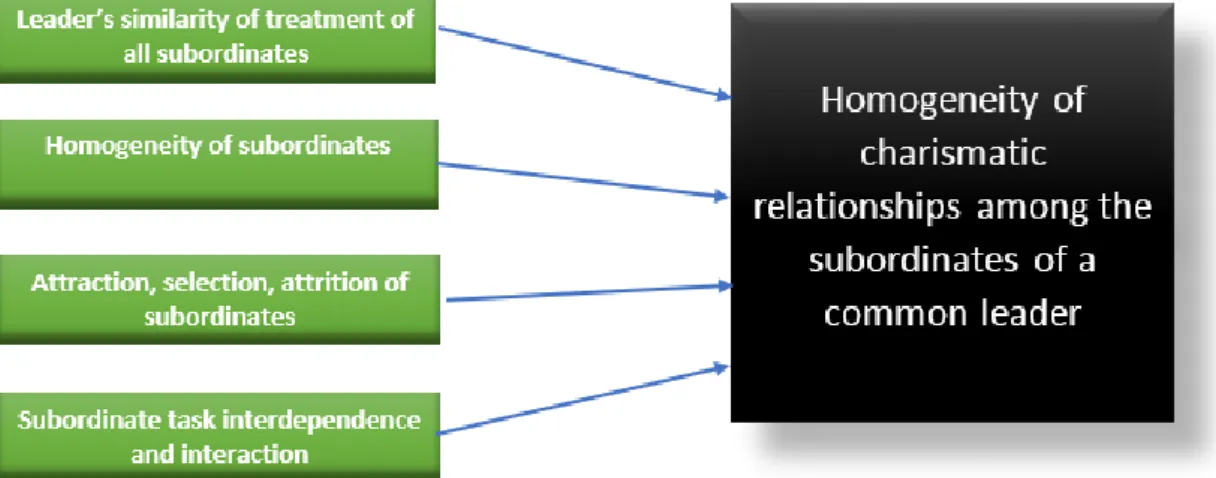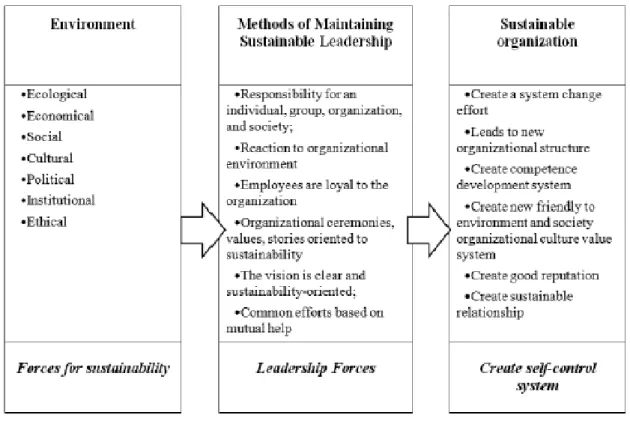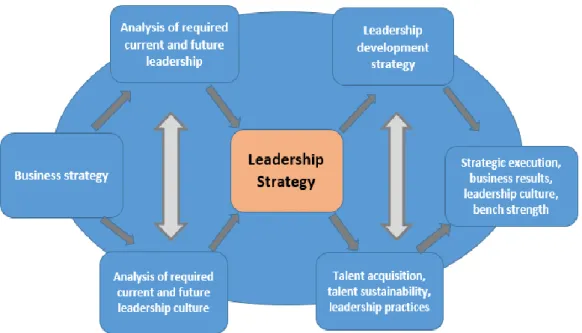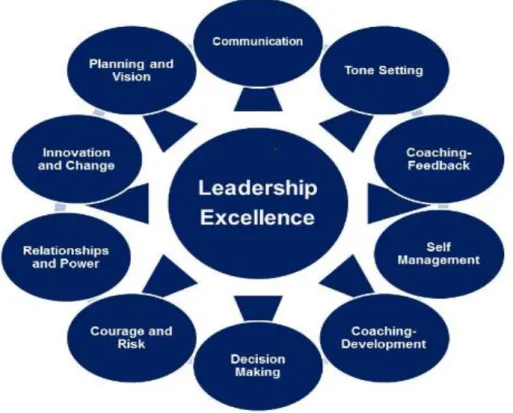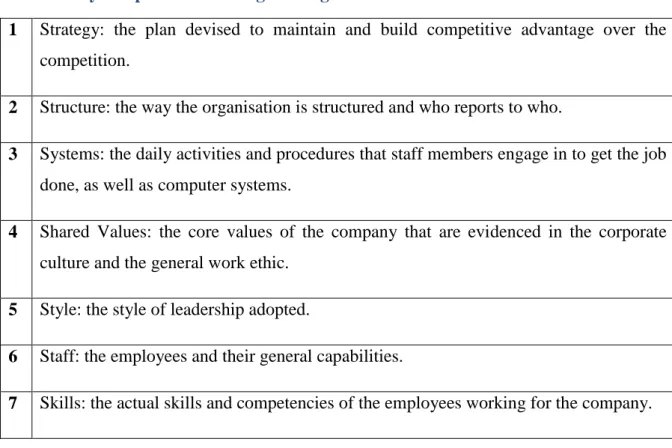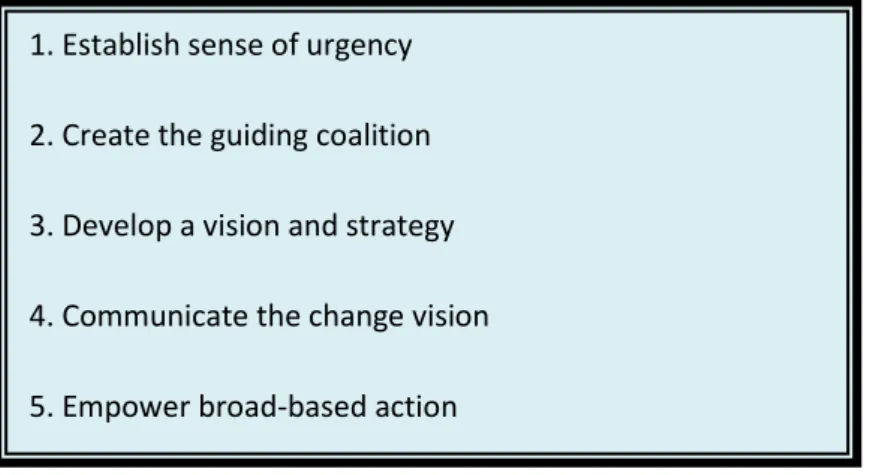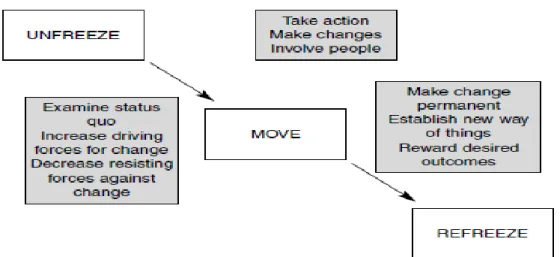UNIVERSITY OF KWAZULU-NATAL
THE IMPORTANCE OF STRATEGIC LEADERSHIP AND CHANGE
MANAGEMENT IN ACHIEVING THE OVERALL NATIONAL SUSTAINABILITY OBJECTIVE: THE CASE STUDY OF UNILEVER
By
Celeste Lisa Enoch 207503563
A dissertation submitted in fulfilment of the requirements for the degree of Master of Commerce
School of Management, IT and Governance College of Law and Management Studies
Supervisor: Dr. Thea van der Westhuizen
2016
i | P a g e DECLARATION
I Celeste Lisa Enoch declare that
(i) The research reported in this dissertation/thesis, except where otherwise indicated, is my original research.
(ii) This dissertation/thesis has not been submitted for any degree or examination at any other university.
(iii) This dissertation/thesis does not contain other persons’ data, pictures, graphs or other information, unless specifically acknowledged as being sourced from other persons.
(iv) This dissertation/thesis does not contain other persons’ writing, unless specifically acknowledged as being sourced from other researchers. Where other written sources have been quoted, then:
a) their words have been re-written but the general information attributed to them has been referenced;
b) where their exact words have been used, their writing has been placed inside quotation marks, and referenced.
(v) Where I have reproduced a publication of which I am an author, co-author or editor, I have indicated in detail which part of the publication was actually written by myself alone and have fully referenced such publications.
(vi) This dissertation/thesis does not contain text, graphics or tables copied and pasted from the Internet, unless specifically acknowledged, and the source being detailed in the dissertation/thesis and in the References sections.
Signature:
Date: 10th October 2016
ii | P a g e ACKNOWLEDGEMENTS
Firstly, I would like to thank God for continuing to bless me. Faith was a key driver in keeping me motivated for the duration of this study.
I would like to express my sincere gratitude to my supervisor Dr. Thea van der Westhuizen for her continuous support of my master’s study and related research, for her patience and extensive knowledge.
To Deepak, thank you for your continuous love and encouragement, not to mention your unwavering faith in me- it is because of you that I have come this far.
Finally, I must express my profound gratitude to my parents, friends and family for providing me with constant support and encouragement throughout this study.
iii | P a g e ABSTRACT
The central purpose of this study is to investigate the importance of strategic leadership and change management in achieving the overall national sustainability objective while using Unilever as a case study. It builds on previous research undertaken with respect to leadership, sustainability and change management. In consideration of the current South African economic environment, this bears a climate of continuous turbulence and uncertainty. The fast moving consumer goods industry is one which is deemed to be a large contributor to economic growth.
Hence, the significance of focusing on Unilever, being one of South Africa’s largest FMCG organisations. Due to global advances and the development of more “mindful consumers”, the shift towards a more sustainable environment becomes one of extreme importance. The study predominately assumed a quantitative approach for data gathering, and a minor qualitative method in the form of open-ended questions, of which were distributed to Unilever employees.
The data was analysed by using statistical methods such as the SPSS system, within which inferential and descriptive statistics were used.
The results from the study indicated that organisational success is dependent on effective leadership, of which must be customised to the organisation and culture, closely relating the nature of South Africans. The results further indicated that effective change is required to progress the concept and execution of sustainability within organisations, all driven by effective leadership implementation. Additionally, more integrated methods of attracting consumers so as to convert their attitudes to achieve the corresponding, desirable behaviour, which will subsequently stimulate the achievement of business opportunities and enhance growth. It further provides a preview into some of current issues experienced by the country as well as the FMCG industry and provides clarity on the areas of focus which require further research in order to capitalise on opportunities in growing both organisational success and the economy. This is essential for a developing country such as South Africa, in terms of playing an active role in progressing the future global economy.
Key words: Unilever; FMCG industry; corporate sustainability; effective leadership; change management; organisational effectiveness; sustainable competitive advantage
iv | P a g e
Table of Contents
DECLARATION ... i
ACKNOWLEDGEMENTS ... ii
ABSTRACT ... iii
CHAPTER ONE ... 1
INTRODUCTION ... 1
1.1 Background ... 1
1.2 Research orientation ... 2
1.3 Research problem ... 5
1.4 Research aim ... 6
1.5 Main Research question ... 7
1.6 Secondary research questions ... 7
1.7 Research objectives ... 8
1.8 Rationale ... 9
1.9 Value of research ... 10
1.10 Chapter plan ... 10
CHAPTER 2 ... 12
LITERATURE REVIEW: AN INTERNAL PERSPECTIVE: THEORIES AND MODELS ... 12
2.1 Introduction ... 12
2.2 Leadership models and framework ... 15
2.2.1 Transformational Leadership (TL) ... 16
2.2.2 Charismatic Leadership ... 21
2.2.3 Sustainable Leadership ... 24
2.3 Change leadership ... 31
2.3.1 The Concepts of Change and Leadership ... 31
2.4 Extension of leadership styles: making effective leaders ... 37
2.4.1 Leadership excellence ... 43
2.5 Criticisms of existing theories ... 45
2.6 Managing Change ... 50
2.7 Conclusion ... 57
CHAPTER 3 ... 58
AN EXTERNAL PERSPECTIVE ... 58
3.1 Introduction ... 58
3.2 Sustainability ... 58
v | P a g e
3.2.1 Sustainability - the global scene ... 66
3.2.2 Sustainability in South Africa ... 69
3.3 Expression of value systems in organisations ... 75
3.4 Green consumerism ... 77
3.5 Economic Issues ... 79
3.6 Challenging the economic status quo ... 81
3.7 Challenge Deliberations: An FMCG Perspective ... 83
3.8 A competitor perspective ... 85
3.9 Conceptual Framework: AUTHORS CONSTRUCTION ... 89
3.10 Conclusion ... 91
CHAPTER 4 ... 93
RESEARCH METHODOLOGY ... 93
4.1 Introduction ... 93
4.2 Research aim ... 94
4.3 Main research question ... 94
4.4 Research objectives ... 94
4.5 Research Philosophy ... 95
4.6 Research Design ... 96
4.6.1 Quantitative research ... 98
4.6.2 Characteristics of quantitative data ... 98
4.6.3 Qualitative exploratory descriptive research design... 101
4.7 Research methodology ... 101
4.7.1 Research approach and research paradigm ... 102
4.8 Study site ... 102
4.9 Target population ... 102
4.10 Sampling strategies ... 103
4.10.1 Questionnaire ... 106
4.11 Sample size ... 107
4.12 Data collection methods ... 108
4.12.1 Data collection instruments ... 109
4.12.2 Characteristics of questionnaires ... 109
4.12.3 Structure of the questionnaire ... 109
4.13 Data quality control (reliability and validity) ... 110
4.13.1 Reliability: ... 111
vi | P a g e
4.13.2 Validity: Internal validity ... 112
4.13.3 Empirical and secondary research ... 113
4.13.4 Data sources ... 114
4.14 Data analysis ... 114
4.15 Pilot test ... 116
4.16 Ethical Considerations ... 117
4.16 Limitations of the study ... 118
4.17 Conclusion ... 119
CHAPTER 5 ... 120
RESEARCH FINDINGS AND DATA ANALYSIS ... 120
5.1 Introduction ... 120
5.2 Data presentation ... 121
5.3 Secondary research questions ... 122
5.4 Research findings (Quantitative data) ... 123
5.4.1 Biographical Information ... 123
5.4.2 Validity of scales of the research study’s main constructs (effective leadership, change management and sustainability) ... 129
5.4.3 Reliability of scales of the research study’s main constructs (effective leadership, change management and sustainability) ... 134
5.4.4 Open ended questions ... 155
5.5 Conclusion ... 160
CHAPTER 6 ... 161
DISCUSSION AND FINDINGS ... 161
6.1 Introduction ... 161
6.2 Reliability ... 161
6.3 Research questions and objectives ... 162
6.4 Empirical findings ... 163
6.5 Main findings ... 172
6.6 Managerial Implications ... 173
6.7 Limitations of the study ... 174
CHAPTER 7 ... 176
RECOMMENDATIONS AND CONCLUSION ... 176
7.1 Recommendations for future research ... 176
7.2 Research contributions ... 177
vii | P a g e
7.3 Ethical considerations ... 178
7.4 Conclusion ... 178
7.5 Final conclusion ... 181
BIBLIOGRAPHY ... 182
APPENDIX ... 206
APPENDIX 1: INFORMED CONSENT... 207
Informed Consent ... 209
APPENDIX 2: QUESTIONNAIRE ... 210
APPENDIX 3: ... 216
ETHICAL CLEARANCE ... 216
... 217
viii | P a g e
List of Figures
Figure 1: The 5 key success factors of business ... 13
Figure 2: Differences in the thought process between a manager and a leader ... 14
Figure 3: The additive effect of transformational leadership ... 17
Figure 4: The determinants of homogeneity of charisma ... 22
Figure 5: Relationship between environment and sustainable organisation ... 26
Figure 6: Model of factors of sustainable leadership ... 29
Figure 7: Elements needed to develop an effective leadership strategy ... 43
Figure 8: Factors required to achieve leadership excellence... 44
Figure 9: Focus areas in relation to organisational change outcomes ... 52
Figure 10: Lewin's three-step model ... 55
Figure 11: Kotter’s eight-step model ... 55
Figure 12: Carnall: Managing transitions ... 56
Figure 13: Sustainability model, consisting of the three spheres of sustainability ... 60
Figure 14: Comprehensive sustainable business model ... 65
Figure 15: World Population Growth, 1950–2050 ... 67
Figure 16: Population growth in Africa ... 67
Figure 17: Model of environmental orientation ... 78
Figure 18: Electricity price increase (%) ... 84
Figure 19: Impact of electricity price hikes on agriculture sector ... 84
Figure 20: Percentage (%) of sample respondents by gender ... 123
Figure 21: Percentage (%) of sample respondents by race distribution ... 125
Figure 22: Percentage (%) of sample respondents by marital status ... 126
Figure 23: Percentage (%) of sample respondents by education level ... 127
Figure 24: Percentage (%) of sample respondents by nationality ... 128
Figure 25: Key elements needed for organisational success ... 158
ix | P a g e
List of Tables
Table 1: Characteristics of sustainable and non-sustainable leadership ... 28
Table 2: Transformational versus Servant Leadership ... 34
Table 3: Key components of change management ... 50
Table 4: Advantages and disadvantages of change management models ... 54
Table 5: Core drivers of sustainability ... 64
Table 6: The co-dependency between water, food and energy ... 70
Table 7: Development of human and organisation value systems ... 74
Table 8: Forms of expression in organisation ... 76
Table 9: Synopsis of the main differences between qualitative and quantitative methods within research. ... 100
Table 10: Sub-group split of total population ... 104
Table 11: Sub-group split of sample population ... 105
Table 12: Quantity in terms of research sources... 107
Table 13: Validity of the construct Change in management ... 130
Table 14: Validity of the construct Sustainability ... 131
Table 15: Validity of the construct effective leadership ... 132
Table 16: Pearson correlations coefficients ... 133
Table 17: Reliability of the construct effective leadership ... 134
Table 18: Reliability of the construct sustainability ... 138
Table 19: Reliability of the construct change management ... 139
Table 20: Correlations between organisational leadership and sustainability ... 141
Table 21: Central tendency measures ... 145
Table 22: Alignment of organisational core activities to organisational core values is important for effective leadership ... 146
Table 23: The ability to innovate and generate greener products is important for corporate sustainability ... 147
Table 24: Green purchasing from environmentally and socially responsible companies (products are non-toxic, water and energy conserving, etc.) is important for corporate sustainability ... 148
Table 25: Level 2 and 3 top management’s ability to demonstrate passion for sustainable development through motivation ... 149
Table 26: Level 2 and 3 top management’s ability to continually strive for performance growth and positive outcomes for sustainability ... 150
Table 27: The Company’s ability to influence consumer behaviour towards making more sustainable purchase decisions ... 151
Table 28: Stakeholders identified from open-ended question 1 ... 157
Table 29: Themes identified from open-ended question 1: ... 157
Table 30: Groups identified from open-ended question two: Which groups do the organisation need to partner with in order to gain further clout (within all facets)? ... 159
1 | P a g e
CHAPTER ONE INTRODUCTION
“An evolving global economy requires pioneering leaders” (Reynolds, 2013, p. 1).
1.1 Background
Global organisations have extended their operations internationally and are frequently infringing the most basic human rights. As such, their operations can negatively impact on the natural environment. The present global corporate landscape may be characterised as one of escalating instability and turbulence. The prevalent phenomenon of globalisation confers new, problematic obstacles for organisations, society at large and governments. Thus environmental protection and economic and social problems require progressive attitudes and the implementation of pioneering techniques for sustainability in an attempt to bring these issues to resolution (Šimanskienė & Župerkienė, 2014). Environmental degradation is closely interlinked with health, thus all the more reason to afford this development more attention. In order for companies to ensure their operations are environmentally friendly and sustainable, strong and effective leadership is required. The focus of this study is then inclined towards Unilever South Africa and the manner in which they currently execute business practices, so as to achieve overall business performance.
Unilever’s business plan is not straight and narrow but constitutes numerous facets of which are required to deliver performance with the objective of achieving positive end business results. The company employs business techniques which embody the construct of ‘inclusivity’
with the intent of generating beneficial impacts on 5.5 million individuals by 2020 (Unilever South Africa, 2016). Unilever’s corporate purpose then states; “to succeed requires the highest standards of corporate behavior towards everyone we work with, the communities we touch, and the environment on which we have an impact” (Unilever South Africa, 2016, p.1). The company’s business strategy centers on driving sustainability through the execution of every organisational practice, where the objective is to grow the business while simultaneously diminishing environmental impact and favorably influencing the society through company brands and products (Unilever South Africa, 2016).
2 | P a g e Considering an organisation as large and successful as Unilever, a global consumer goods industry- a beckoning question which needs to be asked is; how are they able to implement effective leadership so as to improve sustainability and reduce their environmental degradation impact? Presently, we are challenged with far greater social, environmental, and economic threats than ever before, encompassing diminishing global ecosystems, population growth, and unprecedented macro-economic stress (Brown, 2011). With the purpose of averting probable far-reaching disaster in this century, civilisation is being summoned to establish significant socially interactive and systemic changes. Additionally, “some are even challenging us to mobilise to “save civilisation” (Brown, 2008, cited in Brown, 2011, p. 1).
Although moving slower than many might hope, there exists a growing universal movement to approach these complex and unprecedented sustainability concerns (Satterwhite, Miller, and Sheridan, 2015; Hawken, 2007). Leaders and change agents launch major new sustainability initiatives on a daily basis (Brown, 2011), hence the need for higher education to assume a principal role in informing and education for sustainability since a sustainable future is increasingly encouraged. Additionally, with reference to South Africa and its current weakened economic position, the fast moving consumer goods industry has been deemed a major contributor towards upscaling the country’s gross domestic product (GDP), hence it’s increased importance within this context.
1.2 Research orientation
This research focuses on Unilever South Africa (ULSA) as a case study. A multi-national organisation which operates across two corporate offices and seven manufacturing locations across the country. “The Top Employer Institute rates Unilever South Africa, established over 100 years ago, as the country’s No 1 employer in South Africa for three years in a row”
(Unilever South Africa, 2016, p.1). The company comprises a product range that includes foods, homecare, and personal care and is the market leader in 14 of the 17 categories in which it operates in South Africa (Pynchon, 2012). ULSA aims to make a positive impact in numerous ways: through their brands, commercial operations and relationships, through voluntary contributions, and through the various ways in which they engage with society (Unilever South Africa, 2016). The organisation has adopted a long-term business strategy in which to realise their vision within the categories and brands that deliver growth to the benefit of all
3 | P a g e stakeholders. The organisational objective within their strategy is to gain profitable growth while remaining responsible. Unilever’s business model begins with consumer insight that informs brand innovation, often with partners within supply chain, to create products to take to market supported by marketing and advertising across a range of distribution channels (Unilever South Africa, 2015). Given the progression and subsequent issues with social and economic development over the past decade, issues involving technology aimed to decrease dependence on non-renewable resources, infinite energy and sustainability have deviated from the external boarder to the core of the universal economy (Nortech Trinity, 2015). Public and private organisations within all scopes are expected to take cognisance as regards to the great significance imposed on being a responsible corporate citizen in their particular divisions and markets, and to recognise the demands of their stakeholders and customers (Price, 2011).
Numerous organisations are identifying that their core challenge is to ascertain the right leadership within their organisations to proactively address sustainability issues, and convert these into advanced opportunities for growth and development (Bridges, 2010). Definitions of
“clean”, “green” and “sustainable” range further than the various assortment of organisations concentrated on progressing clean technologies, substitute or renewable energy and more environmentally-friendly goods and services. Sustainability in its broadest sense is delineated as a calculated leadership and management subject in practically all spheres of industry, whether business-to-business or consumer. Organisations are required to achieve and exceed consumer expectations relating to cleaner, greener or organic products, and more environmentally friendly methods of executing business to provide and maintain elevated levels of product and services.
This could entail reconsidering each stage from the initial stages of product design, to materials and components, and facilities and distribution strategies—frequently being executed in conjunction with developing governing advances, growing shortage of resources, and escalating expenses. Governments around the world have instituted renewable and feasible resource initiatives as well as the expertise required to attain them, as a vital constituent of both green policy and economic development (Ceasar, 2011). Global non-governmental corporations work to expedite sustainability initiatives on a local and international platform, collaborating to deliver significant programs. Therefore, leadership within the age of sustainability indicates that numerous organisations are assigning leading sustainability majors to earnestly and effectively confront these concerns and transform them into growth prospects (Ceasar, 2011). Effective sustainability leadership necessitates understanding and involvement
4 | P a g e capability through lawful, acquiescence, advertising/communications, IR and research and development spheres, ensuing the generation of a distinctive and inimitable proficiency set which can be challenging to discover within a solitary individual. With regards to the integration of strategic leadership and sustainability for organisational success, Unilever South Africa was targeted as the organisation of study since it is one of South Africa’s largest fast moving consumer goods companies. The burgeoning condition of the industry indicates that there are insufficient high-ranking executives who maintain an established record of accomplishment at scale. Each facet of everyday, regular lives integrates some form of interaction with the environment. We have transformed into a generation incessantly changing, developing and thriving on that which is natural. However, we tend to overlook the fact that these natural resources are not infinite. Eventually, they will become exhausted - what then are the consequences?
A wealth of studies have expressed their immense apprehension towards this issue, as have the corresponding detractors of the problem. Furthermore, on the basis of several assessments, this occurrence will in fact harshly affect the transportation, economy, energy, industrial and food sectors. These effects will sequentially result in noticeably elevated prices for all travel types, amplified prices in food and general retail, along with amplified charges for domestic services, heating and power (International Energy Agency, 2011). So, how does leadership and change management reinforce and acclimatise organisational strategies, in order to maintain a prominently powerful bearing within the market? Leadership and change management are not concepts of mere semantics, thus these are the key areas in which the company must focus in order to sustain itself and reduce environmental damage. Both aspects, if implemented effectively and efficiently, will stimulate elevated levels of success.
Thus efforts must be focused on the comprehension of future realities and how these challenges within the industry can be influenced, overcome, or reduced (International Energy Agency, 2011). The classic quote by Einstein; "we can't solve problems by using the same kind of thinking we used when we created them" Albert Einstein (Mielach, 2012, p.1) appears to be particularly appropriate in light of the sustainability challenge. When considering all efforts put into the sustainable revolution and its corresponding environmental growth strategies, even this does not seem adequate to address the impending undertaking we are challenged with. This may be attributed to our behaviors of thought and practice which hamper our ability to involve both existent and future presentiments (Ceasar, 2011). Mindfulness practices may assist to avert the imminent issues surrounding the sustainability challenge. It facilitates a complete
5 | P a g e interrogation of the present circumstances as well as our core discourse with it, so as to accomplish enhanced communication with others. The capacity to sanction a perspective consistent with the wider sustainability agenda is both precarious and distressing. Behavior displaying excessive contesting during an unsuitable period may risk being ridiculed, not appearing as earnest and genuine, and may support division. However, if one does not portray adequate tenacity to the challenge at hand, he or she may be faced with conspiracy which may hamper the prompting of change. Leadership for sustainability necessitates that an individual must be completely vigilant to their own support and true foundation and must have a thorough comprehension of correct timings and methods of execution. (Sutherland and Smith, 2013 and Ceasar, 2011).
1.3 Research problem
This first decade of the third millennium will be remembered for rapidly increasing international recognition of, and leading to global consensus that, the rate of global warming is accelerating, intensified by preceding and current unsustainable practices of the human race.
These activities, comprising greenhouse gas productions, deforestation, additional depletion of finite resources, reduction of universal biodiversity and pollution of water supplies, give rise to human-influenced consequences which adversely effects our quality of life (Shahid and Ahmed, 2014). In view of the current period we reside in, within which massive developing countries like China and India are experiencing ‘‘energy hungry’’ industrial revolutions, for years our planet has been bombarded by the destructive effects of our activities. With the intention of restricting the accelerating environmental issues, considerable investment in the growth and development and operation of renewable energy technologies, energy efficiency, and sustainability must be implemented (International Energy Agency, 2011).
In the twenty-first century, convincing consumers to make sustainable choices exists as one of the toughest environmental obstacles for businesses to overcome. The dynamics that accompany the engagement of consumers in terms of persuading them to purchase “greener”
products entail a combination of behavioral psychology and technological change (Bertels, Papania and Papania, 2010). Additionally, the financial crisis and consequent recession have compelled consumers towards value offerings, a development that will remain for years to come. This has inevitably led to organisational shrinking margins causing a decrease in consumer spending power. According to a McKinsey study, 70% of consumers are searching for more cost effective methods in order to save money and approximately 15% are purchasing
6 | P a g e more economical brands (Satterwhite et al, 2015). The fast moving consumer goods industries (FMCGs) are progressively compelled by retail conglomerates to offer concessions on pricing, delivery and various other terms and conditions. Therefore, the consumer proposition requires modification in order to set forth a more sustainable design, which is more persuasive than on- shelf substitutes, and delivers on what has been promised. In this regard, reference is made to one of the largest FMCG’s in South Africa, Unilever. Maintaining continued success within a massive company such as this, will require numerous initiatives in order to efficiently produce and market the thousands of products supplied by the company. How then does a corporation of such large scale, reduce its impact on the environment and contribute to sustainability?
Sustainability initiatives cannot be driven through an organisation the way other changes can.
There exist distinctive phases which require diverse organisational aptitudes and leadership experiences (Parry, 2011).
Theory and practice are not always aligned, thus this thesis will comprise a thorough analysis of leadership and change management in tandem with sustainability, in terms of how a multinational corporation institutes sustainable action to employ green policies that can attract the growing ethical consumer market and maintain continued success. It further seeks to obtain authentic information regarding leadership in practice and how theory can be used to better enhance leadership execution. The thesis investigates the constructs surrounding leadership and what is required to implement effective change in accordance with sustainability within the FMCG industry. The execution of sustainable leadership, change management and the integration of revised and more apt business strategies are essential to facilitate the sustenance of the company’s dominant position in the market.
1.4 Research aim
The importance of strategic leadership and change management in achieving the overall national sustainability objective: The case study of Unilever.
The general aim of this study is to explore how leadership and change management can be utilised effectively, to decipher how a fast moving consumer goods company can modify its business model, ensuring the continued success of the company, inclusive of a competitive advantage, within a turbulent environment of increasingly significant concerns and uncertainty.
This, in addition to delivering products on a regional level and effectively utilising resources.
7 | P a g e Furthermore, the study aims to identify factors that assured success in the past, which are now ineffective and how the company should work towards adapting additional techniques to ensure future sustained success.
1.5 Main Research question
The importance of strategic leadership and change management in achieving the overall national sustainability objective: The case study of Unilever.
1.6 Secondary research questions
The secondary research questions relate to Unilever as mentioned in the main research question.
1.6.1 What type of leaders are required for successfully operating within the fast moving consumer goods industry (an emerging industry comprising rapidly changing markets, with Unilever South Africa as the benchmark)?
1.6.2 What type of cultural assessment integrated into the recruitment process is used to guarantee that the right leaders for an organisation are presented for long-term success?
1.6.3 What are the links between efficient organisational leadership and the progression of sustainability?
1.6.4 What type of business model is required to afford better customer propositions that are inherently more sustainable?
1.6.5 With consideration to the exploding global middle class, how do we find methods for creating greener consumers?
1.6.6 How will Unilever employ green policies that can attract the growing ethical consumer market?
8 | P a g e 1.7 Research objectives
The research objectives relate to Unilever as indicated in the main research question.
The below research objectives pertain to Unilever South Africa:
1.7.1 To determine the type of leaders that are necessary for companies to succeed within fluctuating environments.
1.7.2 To identify the type of evaluation used to select the right leaders in ensuring long-term organisational success.
1.7.3 To identify the connection between effective organisational leadership and the advancement of sustainability.
1.7.4 To determine what type of business model is best suited to generate enhanced customer offers that are integrally sustainable.
1.7.5 To understand the dynamics surrounding the current economic state and decipher methods of creating greener consumers.
1.7.6 To determine the methods to be implemented by Unilever in order to attract the increasing ethical consumer market.
9 | P a g e 1.8 Rationale
This study comprised of responses gathered from participants employed by Unilever. These participants were both Level 2 and 3 management in conjunction with Level 1 employees.
Management are essentially responsible for the execution of business strategies within the organisation. They are required to organise and plan as well as use acquired skills to inspire employees to embrace strategic organisational changes. Management leads strategy and change and addresses the “when”, “how” and “why”. Although Level 1 employees are not responsible for strategic choices and implementation, they are responsible for executing strategies management needs to implement.
This research chose to investigate perceptions from Level 1 employees, as well as Level 2/3 management. The reason for this is that management might have a certain perception on strategy implementation and the Level 1 employees might have another perception. It is therefore important that the research investigate the degree of success Unilever has in its strategic implementation of its national sustainability objective through looking at lenses of different level of employees, and how the strategic implementation process is being led. The era of the 21st century has presented both difficulties and opportunities to corporate organisations.
South Africa is deemed the most competitive economy within sub-Saharan Africa, however, it is essential that focus be shifted to these corporate prospects with the objective of enhancing efficiency and competitiveness. It is important to examine the underlying factors of successful leadership in terms of leadership style, overall organisational vision, the way human resources are utilised, and knowledge and formulated paradigms that will assist and drive the progression of effective change management, to achieve environmentally sustainable success. This study indicates the complexity in guiding an organisation towards success and through the research conducted it determines first hand, how companies are able to attain their competitiveness.
10 | P a g e 1.9 Value of research
Few research studies have been directed towards methods of execution of sustainable leadership and the incorporation of effective change management within the FMCG industry and with consideration of the current economic climate. This research study thus expands on existing literature on sustainable leadership and change management in terms of adaptation towards modern strategies and its overall nature and potential to achieve success. It further facilitates the achievement of a comprehensive understanding of leadership strategies executed within FMCG’s in South Africa which will afford the opportunity to develop customised resolutions to issues regarding sustainable leadership, change management and the preservation of a sustained competitive advantage.
1.10 Chapter plan
Chapter 1 provides an introduction and background to the study, in addition to stating the research focus and related objectives. It discusses the rationale and the value of the research.
Chapters 2 and 3 provides a discussion of the literature review which sets the foundation for the study. The literature reviewed is consistent with the factors of leadership, change management and sustainability, and affords information outlining the FMCG industry issues in tandem with a current, corresponding economic perspective.
Chapter 4 presents the research methodology, and discusses the research design and methods used within the study, in addition to the methods for interpreting and analysing the gathered data.
Chapter 5 presents the collected findings, including an analysis and interpretation of the information collected from the research questionnaires.
11 | P a g e Chapter 6 comprises a comprehensive discussion of the findings obtained with regard to the literature provided. It collectively discusses the overall purpose of the study corresponding to the research objectives and the associated findings.
Chapter 7 summarises the study as a whole and provides the final conclusions of the study consistent with the findings acquired. From this, subsequent recommendations are suggested in tandem with the emergent limitations of the study.
12 | P a g e
CHAPTER 2
LITERATURE REVIEW: AN INTERNAL PERSPECTIVE:
THEORIES AND MODELS
“If your actions inspire others to dream more, learn more, do more and become more, you are a leader”. —John Quincy Adams (Kruse, 2012, p1).
2.1 Introduction
Numerous individuals believe that leaders are not born but rather made (Andersen, 2012). It has become progressively more believed that experience, commitment, a vast knowledge set, tolerance and essentially the ability to compromise with others to arrive at common goal accomplishments, are the requirements of an effective and worthy leader. Operative leadership is established via a continuous process of learning, self-study, preparation, and the growth of pertinent skills and understanding (Bass and Bass, 2008). Waters-Lynch, Potts, Butcher, Dodson and Hurley (2016) summarises the overall trans-disciplinary theory of awareness and human, societal, and organisational behaviour by stating that the foundation of effective leadership is derived from resilient character and self-effacing commitment to an organisation (Bourne and Jenkins, 2013). To many, management is perceived as leadership which is a common misconception (Fallon, 2014). Leadership is essentially derived from influence (Eustace and Martins, 2014).
One’s ability to display authenticity and provide direction, whilst simultaneously motivating others in a positive manner towards the achievement of a shared mission and vision, is a sign of effective leadership implementation (Fallon, 2014). Leadership encompasses a form of accountability intended to realise specific expectations by relating accessible resources (human and quantifiable) and guaranteeing a consistent and comprehensible union in the process (Ololube, 2013). Therefore, in order for a company to succeed, it is imperative that proper leadership be executed, hence the deployment of ‘‘strategic leadership’’. The literature review has been divided into two chapters. Chapter 2 discusses an internal perspective regarding leadership issues and organisational strategy perspectives. This is in line with the focus of the study, as the research is centred on the importance of strategic leadership and change management in terms of achieving Unilever’s overall national sustainability objective. The
13 | P a g e chapter provides an overview and discussion of present leadership theories and discusses the importance of each theory. These theories are then assessed by the researcher in accordance with the nature of Unilever and through investigation, the most appropriate leadership method is suggested to be applied within the organisation for best overall performance. Chapter 3 provides an external perspective. This discusses the South African economy at large, the nature of the fast moving goods (FMCG) industry, sustainability and factors influencing growth from a peripheral standpoint. It is necessary for an overview of external factors to be provided, in order to decipher the current position of the South African market and where an organisation such as Unilever fits within the bigger picture.
Figure 1: The 5 key success factors of business
Source: Total Success Center, 2015, p. 1.
When considering organisational success, it is important to note that the implementation of a specific leadership strategy needs to incorporate various elements in order to stimulate business growth. As such, five key elements have been distinguished as per Figure 1 above. The key factors of business success differ from leadership in four ways. It requires that both the internal and external environments of the association be focussed upon in conjunction with its tactical position. It has the propensity to engage to a large extent, more multifaceted and ambiguous dimensions than leadership (Denis, Kisfalvi, Langley and Rouleau, 2011, p. 71- 85). It induces a more integrated and multifunctional approach and encompasses leading by means of other leaders, or more commonly stated, ‘leading by example’. This study embodies the recognition of the affiliation between both leaders and followers, as well as the methods employed by these leaders to facilitate the coordination of decisions and actions that will determine the future of
14 | P a g e the organisation (Denis et al, 2011, p. 71- 85). Leaders institute different ways of leading.
Within every organisation different methods of working are employed. These methods may be described in the form of a specific nature or strategy which the leader assumes and these constitute seven methods of action logic or transformations of leadership, which may be outlined as follows:
Opportunist.
Diplomat.
Expert.
Achiever.
Individualist.
Strategist.
Alchemist (Rooke and Torbert, 2005).
Source: Naylor, 1999, p. 524.
Figure 2: Differences in the thought process between a manager and a leader
15 | P a g e Northouse (2007) and Rowe (2007) described leadership as a process whereby an individual impacts or stimulates a group of people to realise a shared objective. This study advocates that effective leadership is critical to the proper procedures and accompanying success of an FMCG organisation. Leadership is debatably one of the most observed, yet least implicit phenomena on earth (Abbasialiya, 2010). Over time, numerous leadership styles have been proposed yet none have been deemed universal. Regardless of the varied styles of leadership, an effective and proficient leader is one that stimulates, encourages, and leads in order to assist in attaining organisational goals. On the contrary, an ineffective leader will not be capable of promoting corporate growth and can steer away from organisational achievement. Naylor (1999) states that effective leadership is the resultant effect of a leader being at his/her core: idealistic, enthusiastic, imaginative and inspired, flexible, innovative, courageous, motivating original, investigational, and is willing to instigate change (see Figure 2).
2.2 Leadership models and framework
Diverse interpretations of leadership exist in conjunction with the many differing characteristics that differentiate leaders from non-leaders. Most current research has drifted from personality-based or traditional theories to situational theory (Collinson, 2011). This necessitates that the position in which leadership is implemented is gauged by the leadership abilities and characteristics of the leader (Avolio, Walumbwa, and Weber, 2009). All current theories can be grouped under one of three types: leadership as a process or relationship, leadership as a combination of traits or personality characteristics, or leadership as certain behaviours, more commonly referred to as leadership aptitudes.
Within the more prevailing notions of leadership, there exists the perception that to a certain extent leadership is a method that comprises dominance with a collection of individuals toward the apprehension of objectives (Wolinski, 2010) and (Amanchukwu, Stanley and Ololube, 2015). It is important to acknowledge that leadership in its essence is required to be authentic.
It needs to draw from both positive psychological capabilities and a highly developed organisational context, which sequentially effects greater self-awareness and self-regulated positive behaviors on the part of leaders and employees, inevitably adopting positive self- development. A common criticism within the leadership literature has been summarised and states that there are comparatively limited studies in any of the areas of leadership research
16 | P a g e have aptly addressed levels-of-analysis issues within theory, measurement and data analysis.
Simultaneously, several scholars have conveyed their apprehensions towards Luthans and Avolio’s original definition of leadership authenticity (Avolio et al, 2009). There appears to exist common consensus in literature on four specific elements which outline the constituents of leadership, these are balanced processing (being able to objectively analyse information prior to making a decision), an internalised moral perspective (to be guided by internal ethical standards in order to control ones behavior), relational transparency (being open and honest regarding information and emotions), and self-awareness (refers to the confirmation of an individual’s strengths and weaknesses. These four elements have been proven reliable as per Walumbwa and associates, subsequent to further investigation (Avolio et al, 2009).
2.2.1 Transformational Leadership (TL)
Different leadership approaches are required for different situations, therefore this analysis will incorporate a discussion of the contingency theories of effective leadership, as well as the constituents of transformational and strategic leadership. Residing in a world amid growing uncertainty, leaders are required to adapt their behaviours within a transforming environment (Yukl, 2011).
‘‘Transformational leadership is the process by which a leader fosters group or organisational performance beyond expectation by virtue of the strong emotional attachment with his or her followers combined with collective commitment to a higher moral cause’’ (Díaz- Sáenz, 2011, p. 299).
It is a process which cultivates aptitude enhancement and facilitates the transmission of elevated levels of personal dedication towards organisational goals. In light of the above, transformational leadership can be further described as a phenomenon which:
‘‘… facilitates a redefinition of a people’s mission and vision, a renewal of their commitment and the restructuring of their systems for goal accomplishment. It is a relationship of mutual stimulation and elevation that converts followers into leaders and
17 | P a g e may convert leaders into moral agents. Hence, transformational leadership must be grounded in moral foundations’’ (Leithwood and Jantzi, 2000, and Cashin, Crewe, Desai, Desrosiers, Prince, Shallow, and Slaney, 2000, cited in: Hay, 2006, p. 4).
From the above quotation it is apparent that transformational leadership encompasses many dimensions and is an effective approach in executing organisational functions. In accordance with how the company will plan suitable strategies to further progress, it can be proposed that transformational leadership is an effective leadership approach (Qureshi and Shahzadi, 2013).
This is due to its versatile nature and may perhaps afford leaders the ability to enhance their strategies. Accordingly, four significant factors have been distinguished as being demonstrated by effective leaders, as the factors which spur the successful execution of the TL theory i.e. the additive effect of transformational leadership. These factors are shown in Figure 2.3 below.
Figure 3: The additive effect of transformational leadership
Source: Hall, Johnson, Wysocki and Kepner, 2002, p. 2, cited in: Hay, 2006, p. 5.
18 | P a g e Thus the organisation under study will need to utilise the approach of transformational leadership to ensure its successful advancement (García-Morales, Jiménez-Barrionuevo and Gutiérrez-Gutiérrez, 2012). As a result of increasing uncertainties within the business environment, leadership must employ creative and innovative measures so as to impact organisational performance in a positive manner. Seven theoretical models have been designed to explain leader performance in pioneering efforts, and its significance within the industry has prompted two main questions:
(1) In what ways can organisations arrange themselves to facilitate and encourage inventiveness and innovation? (2) When is the appropriate time to make investments in innovation? (Mumford, Robeldo and Hester, 2011). Within the leadership context it is essential for power relations and identity constructions within the organisation to be examined to determine the ways in which leaders may execute their authority more effectively and cogently, so as to maintain an environment of trust and loyalty (Collinson, 2011). Reflecting on the above mentioned limitations, one must consider the ways in which leadership can be implemented efficiently and effectively to ensure success (García-Morales et al, 2012).
Due to the varying nature of the economy and world markets, it becomes essential for a new, changed structure of leadership to be executed, thus the deployment of ‘transformational leaders’ (i.e. those who generate something new from something old) (Tichy and Ulrich, 2008).
Transformational leadership far surpasses the conventional alterations to the organisational mission, and endorses essential changes within the organisation’s central political and cultural systems (Choudhary, Akhtar and Zaheer, 2013). It is this element that distinguishes transactional leaders from transformational leaders. Critical to transformational leadership are the dynamics of change (Antonakis and House, 2013).
These are founded on three assumptions, the first being that a trigger occurrence signifies a need for change. This allows for mixed feelings- both a positive drive for change and a forceful negative resistance from individuals and the organisation. The second aspect of change then infers the element of resistance and will be now be briefly expanded upon. Resistance is suggested to arise from three systems: technical, political, and cultural systems (Tichy and Ulrich, 2008). Tichy and Ulrich (2008) state that technical systems resistance comprises of task-based pattern and inertia, and the apprehension of change itself. Political systems resistance may arise from inner coalitions in opposition to change, restrictions on resource accessibility, and the notion that the necessity for change is a condemnation of past leadership.
19 | P a g e Resistance within cultural systems is based on the premise that ‘‘an organisation is one thing, and cannot be another’’ (Tichy and Ulrich, 2008, p. 2). It regards past history as maintaining security, and that existing organisational culture makes change complex. The final assumptions of change assumes that ‘quick-fix’ solutions do not work and that a transformational leader is required. A transformational leader is believed to be the solution to ‘revitalisation’ so as to generate a new vision, activate dedication and devotion to that specific vision, and institutionalise these adjustments to some extent, by measuring and restoring organisational culture (Tichy and Ulrich, 2008). Success may be achieved through transformational leadership and strategic leadership, both types having close connections. Strategic leadership can be delineated in many ways. However, essentially its theories relate to the management of organisations (Rothaermel, 2015) and thus can be viewed as a collective cognition (Denis et al, 2011). Strategic leadership studies have conventionally emphasised the analysis of the top management group in terms of three theories (Musca, Perez, Rouleau and Giordano, 2009).
Theory one is the ‘upper echelons theory’, which has been viewed as the most commonly instituted approach to strategic leadership presented in academic literature. ‘‘Organisations are reflections of top managers’ cognitions and values” (Hambrick, Humphrey and Gupta, 2015, p. 519). Two central ideas have predominately been used to characterise strategic leadership which are ‘‘the capacity of top managers to make strategic decisions” and “to drive the organisation towards success’’ (Musca, et al, 2009, p. 1). Theory two is characterised by ‘‘the charismatic, transformational and visionary perspectives (Antonakis and House, 2013). The third theory is ‘‘the cognitive complexity and social intelligence approach’’ theory (Hunt, 1991; Hooijberg, Hunt, and Dodge, 1997, cited in: Musca, et al, 2009, p. 1).
The main differences between them encompass the fact that human cognitive drawbacks, specific experiences, preferences, and characters of top managers may have significant impacts on tactical choices and thus organisational performance. In addition, the collective traits of top management teams as an assembly would be more apt in gauging strategic decision-making models, due to their cumulative nature. A strength of the collective execution of the strategic and transformational perspective demonstrates that tactical leaders can and do make a difference to strategic decisions and performance results (Denis et al, 2011). The significance of viewing the management team as a collective unit is also essential, as it is through collaborative and integrated working that goals are achieved successfully (Denis et al, 2011).
Viewed in a somewhat different manner, a second perspective with regard to strategic leadership deems strategic leadership as individual inspiration. Denis et al (2011, p. 75) states
20 | P a g e that ‘‘this perspective can be seen as an outgrowth of the ‘great man’ or ‘heroic’ theories of leadership’’. Studies directed towards comprehending the factors that propel individual strategists have transformed their function in the strategy process. This perspective amalgamates emotions and illustrates a further holistic representation of the strategist as a
‘feeling-thinking-acting’ individual. However, since it is founded on sole-case or ethnographic research, encompassing generality posed challenges (Denis et al, 2011). Two gaps are then found within strategic leadership studies: literature regarding strategic leadership fails to adequately consider the manner in which the environmental and organisational framework is substantial in executing tactical leadership and it has been perceived to impede organisational flexibility (Rothaermel, 2015).
Additionally, environmental dynamics are becoming increasingly more uncertain and risky, thus the strategic requisites have not been appropriately dealt with. Furthermore, the limitations of the above two perspectives are that they implicitly or unambiguously have the tendency to presume, via their positions, that executives at the top involuntarily have the control needed to persuade organisations and execute decisions (Denis et al, 2011). Strategic leadership as political action is the third aspect of strategic leadership. Since top management frequently encounters difficult decisions regarding the distribution of resources, leaders must organise and entrust authority to tactical positioning, being aligned with competing interests. Power is defined as: ‘‘a casual relation between the preferences of an actor regarding an outcome and the outcome itself’’, while politics refers to individual or group behaviour that ‘‘makes a claim against the resource-sharing system of the organisation’’ (Pettigrew, 1977, p. 81, cited in Denis et al, 2011).
Thus, activating power could possibly improve leaders’ capacity to strategically manoeuvre their organisation, or if the methods are viewed as unlawful, the leadership position of the individual may be compromised. However, there remains an inherent contradiction regarding this aspect. Regardless of leaders’ best intentions, they may not be capable of constantly executing lawful and controlled decision-making practices, thus a barrier remains for leaders to preserve adequate power to direct politics (Denis et al, 2011). Finally, a forth perspective proposes strategic leadership as social practice. This aspect originated from discontent associated with conventional outlooks on leadership that it was deemed too disjointed from daily pragmatic experiences. It is suggested that being alert to the concealed actions and discourses forming the core of strategic leadership, a ‘social practice’ generates data linked to strategist’s existing know-how. However, this perspective does not offer generic guidelines to
21 | P a g e being a successful strategic leader. Instead, it generates related and explanatory information, which aims to thoroughly investigate and determine the diverse approaches to executing strategic leadership (Denis et al, 2011).
SYNTHESIS:
The points below summarise the key factors to be noted within the construct of effective leadership.
The type of leadership executed within a company is an essential factor which contributes to maintenance and continuation of organisational success (García-Morales et al, 2012).
Transformational leadership has proven to relay this organisational benefit (Choudhary, Akhtar and Zaheer, 2013).
Transformational leadership is characterised by enhanced consciousness of a collective interest amid employees (Choudhary, Akhtar and Zaheer, 2013).
Transformational leadership emphasises feelings, principles, and the significance of leadership positioned towards encouraging employee creativeness (García-Morales et al, 2012).
Strategic leadership forms an additional element of the attainment of organisational success (Choudhary, Akhtar and Zaheer, 2013).
Despite its benefits, strategic leadership research has its flaws, namely the current literature does not adequately consider the importance of the environmental and organisational framework in executing tactical leadership (Rothaermel, 2015).
The following segment discusses the area of charismatic leadership.
2.2.2 Charismatic Leadership
When we refer to leadership in the traditional sense, it may be viewed as that which generates obedience, respect and support (Anderson, Ford and Hamilton, 1998; cited in: Eustace and Martins, 2014). On the other hand, an alternate view presented by Daft (2014), contends that
22 | P a g e the main focus of leaders falls within the investment in individuals as opposed to employee output which allows for the nurturing of constructive relations which enhance efficiency (Eustace and Martins, 2014). Hence it seems as though there is a transferral of importance to empowerment, motivation, and the inclusion of supporters. Within the more recent literature, leadership can be denoted as the skill of altering behaviour of individuals and organisations with the purpose of implementing advantageous changes (Parry, 2011). Figure 4 below displays the determinants of homogeneity of charisma which are required for charismatic leadership.
Figure 4: The determinants of homogeneity of charisma
Source: Waldman and Javidan, 2013, p. 13.
Contemporary leaders are more prone to cultivating respect, genuine consideration of and gratitude for their employees, recognising them as an important basis for information, achievement and invention which are all elements required for improving organisational success (Oyetunji, 2006). Additionally, it is deemed highly significant to recognise and understand the cultural models existing within organisations as well as the manner in which individuals perceive leadership (Mbigi, 2004). Once a comprehensive understanding is established, it becomes easier to determine a method in which appropriate leadership can be executed suitable to that particular organisational climate. With specific reference to South Africa and the South African culture, it is believed that leadership can be considered as embracing the elements of self-respect, people satisfaction, partnerships, and functioning as a
23 | P a g e joint entity; a term better recognised as Ubuntu (Schutte and Barkhuizen, 2016). Thus African leadership is acknowledged as that of understanding, collaboration and unity. Since this study is situated within one of South Africa’s biggest fast moving consumer goods companies, it becomes necessary to highlight the major values of African leadership in contemporary times.
It is a requirement that organisations be dedicated to integrating African leadership methods, which necessitate involvement, responsibility and transcendent ability in addition to visibility, accountability and validity (Eustace and Martins, 2014). In reference to the brief discussion on charismatic leadership stated earlier in the chapter, and for the purpose of this study, we may discuss at a higher level, neo-charismatic leadership which incorporates transformational, African and charismatic theories. Charismatic theory then exists as an addition to attribution theory (Waldman and Javidan, 2013).
Charismatic leadership then assumes that employees may impart informal leadership skills to leaders subsequent to observing and recognising particular actions displayed by their leaders, which stems from their observance and learnings of leader behaviour. Steve Jobs and John F.
Kennedy can be viewed as charismatic leaders (Conger and Kanungo,1987). Transformational leadership comprises ethics, ideals, principles and long-term objectives, which are viewed as a necessary component of charismatic leadership (Northouse, 2007). Nelson Mandela was one of the extraordinary, charismatic and transformational leaders of our time. He was an individual who inspired change, and expressed and drove a shared vision towards a transformation within his beliefs. African leadership is constructed upon accountability, transparency and teamwork (Eustace and Martins, 2014). African leadership encompasses six critical values:
Respect for the dignity of others.
Group solidarity (an injury to one is an injury to all).
Team work is greater than the efforts of the individual.
Service to others in the spirit of peace and harmony.
Interdependence and connectedness.
Persuasion (Mbigi, 2004; cited in Eustace and Martins, 2014, p. 3).
24 | P a g e SYNTHESIS:
The points below summarise the elements to be considered within leadership in the South African context. Within a South African context, it is important to consider the factors that South Africans (employees, employers and the public) deem important within business (Eustace and Martins, 2014).
African leadership is acknowledged as that of understanding, partnership and unity.
Operating in contemporary times within South Africa, it is important to note the major values of African leadership, which are accountability, participation, superior capability and transparency (Eustace and Martins, 2014).
Neo-charismatic leadership incorporates transformational, African and charismatic theories which is beneficial to South African operating organisations (Eustace and Martins, 2014).
The flowing segment discusses the element of sustainable leadership.
2.2.3 Sustainable Leadership
When considering sustainable development, it is important to keep in mind sustainable leadership at both a national and regional level alongside organisational cultural variances. The sustainable development agenda became the key progressive factor in the European Union growth strategy (the EU’s growth strategy towards becoming a sustainable and inclusive global economy, thus affects every country universally), indicating the vital role this aspect serves within success due to a global shift. It then becomes necessary to set key sustainable leadership objectives which establish the development of economic, social and environmental dimensions of organisations. It is a given that there are numerous discrepancies amongst developed and developing countries with respect to sustainable development (Day and Antonakis, 2012).
In essence, countries and organisations within developing countries should use the sustainability agenda as an opportunity to develop themselves further, as society is increasingly taking a keener interest in the role of corporate social responsibility (Drexhage and Murphy, 2010). From an organisational perspective, sustainable development refers to the implementation of business tactics and undertakings which currently fulfil the requirements of an organisation and its stakeholders whilst concurrently supporting, defending, and growing natural and human resources required for future prospects. The foundation of sustainable
25 | P a g e development encompasses three dimensions of (a) economic sustainability, (b) environmental sustainability and (c) social development sustainability (Melville and Ross, 2010).
(a) Economic sustainability comprises adequate and constant economic growth, for example, low inflation rates and conservation of economic constancy (Čiegis and Gineitiene, 2008).
(b) Closely associated with this is environmental sustainability which necessitates that focus be placed on the biological and natural and physical systems (Molchanov, 2011).
(c) Social sustainability incorporates the association within the growth and prevailing social rules currently imposed, pursuing the conservation of steady and consistent social systems (Šimanskienė and Župerkienė, 2014).
It is imperative for organisations to understand that ecological systems and businesses are intimately connected, and future organisational success is reliant on the company’s capability to successfully integrate into the natural environment (Šimanskienė and Župerkienė, 2014).
The following Figure 5 displays the relationship between the environment and a sustainable organisation.
